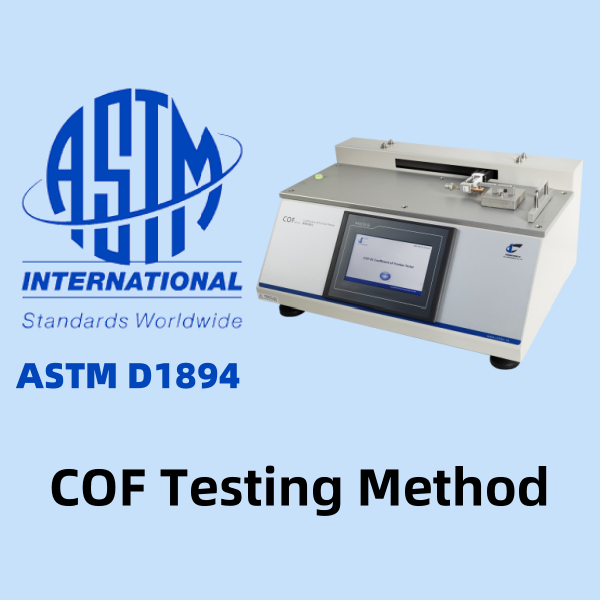ASTM D1894
COF Test Method
When it comes to evaluating the slip properties of plastic films, paper, coatings, and packaging materials, ASTM D1894 is the go-to international standard. This method determines both static and kinetic coefficients of friction (COF), which are critical for assessing how materials interact during processing, packaging, or end-use applications. Friction performance directly affects how smoothly packaging materials run on machines and how they behave during stacking or transportation.
Understanding ASTM D1894 and Its Importance
Understanding ASTM D1894 is essential for industries such as packaging, food, medical, pharmaceutical, textiles, and quality inspection agencies, all of which rely on consistent material behavior for quality assurance.
ASTM D1894 testing outlines a clear procedure to determine the frictional characteristics between two surfaces under controlled conditions. This test is vital for:
- Evaluating packaging material performance
- Ensuring smooth production line operations
- Preventing product damage during shipping
- Meeting customer requirements for material consistency
According to the standard, a COF тест involves pulling a sled—coated with or made from the test material—across a flat surface at a specified speed and pressure. The resistance encountered helps determine the static (initial) and kinetic (sliding) friction coefficients.
ASTM Coefficient of Friction Parameters and Conditions
The ASTM coefficient of friction test specified in D1894 is conducted under the following conditions:
- Тестова скорост: 150 ± 30 mm/min
- Тегло на шейната: 200 ± 5 g
- Temperature and Humidity: Standardized environmental conditions to ensure consistency
- Specimen Dimensions: Usually 63.5 mm x 127 mm, with flat, uniform surfaces
И двете static COF (measured as the force to start motion) and kinetic COF (measured as the force to maintain motion) are calculated. The frictional force is measured in newtons and divided by the sled weight to determine the coefficient values.
Step-by-Step COF Test Method According to ASTM D1894
The COF test method включва следните стъпки:
- Condition the specimens in a standardized atmosphere for at least 40 hours.
- Place the sled (facing down with the test surface) on the base material.
- Connect the sled to the force sensor via a string or hook.
- Initiate motion at a constant speed and record force values.
- Determine the static COF from the peak force before motion begins.
- Determine the kinetic COF from the average force during steady motion.
- Report the results including material type, environmental conditions, and test parameters.
Proper calibration, flat placement, and consistent speed are critical to avoid deviations.
Choosing the Right Co-efficient of Friction Tester
To meet the precise requirements of ASTM D1894, a specialized co-efficient of friction tester is necessary. A reliable tester ensures repeatability, sensitivity, and compliance with the standard. At this point, Cell Instruments’ COF-01 Coefficient of Friction Tester stands out as an ideal solution. It’s engineered for:
- Accurate static and kinetic COF measurements
- Automatic force calibration and high-speed data acquisition
- Compliance with ASTM D1894, ISO 8295, and TAPPI T816 standards
This instrument is suitable for plastic films, paper, foils, textiles, laminates, and more. It is widely adopted by QC laboratories, packaging manufacturers, converters, and research centers to improve consistency and process efficiency.
Contact Us Get ASTM D1894 Testing Solution
Whether you’re in plastics, paper, packaging, or medical device manufacturing, understanding and applying ASTM D1894 gives you a competitive edge. With the right coefficient of friction tester like the COF-01 from Cell Instruments, your operations will be more consistent, efficient, and compliant.
Contact Клетъчни инструменти today to learn how our solutions can enhance your testing capabilities and product quality.
Често задавани въпроси
It measures the static and kinetic coefficients of friction between two surfaces, typically in packaging and materials testing.
It ensures that packaging materials behave consistently during handling, transportation, and automated production.
Common materials include plastic films, coated papers, laminates, foils, and textiles.
Static COF is the force needed to start movement, while kinetic COF is the force needed to maintain movement.


